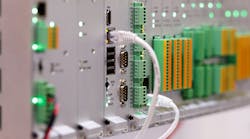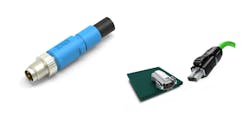This article is part of the TechXchange: Single Pair Ethernet.
What you’ll learn:
- What is single-pair Ethernet?
- How single-pair Ethernet is changing manufacturing.
- Types of connectors for SPE.
Trends such as the industrial Internet of Things (IIoT) and Industry 4.0 are behind the push for new standards for wired connectivity in industrial automation and smart factories. The introduction of IoT technology in an industrial setting involves sensor nodes that don’t require much power or bandwidth but demand reliable, efficient communication.
Industry 4.0 applications in connected factories also need fast and reliable transmission—sometimes near real-time communication or at least guaranteed transmission within a defined time window.
That said, the proliferation of Ethernet protocols in new application areas, including transportation (trains, self-driving cars, and airplanes), is the result of increased throughput that RJ45 can no longer handle.
The automotive industry, for example, has adopted Ethernet to replace traditional controller area network (CAN) bus systems, and its technology enables higher data rates for advanced driver-assistance systems (ADAS) and infotainment systems. In this demanding application, single-pair Ethernet (SPE) can provide that required data rate over a cable similar to CAN designs, but it also offers increased speed and reliability.
SPE features a pair of copper wires that can transmit data at speeds of up to 1 Gb/s over short distances while simultaneously delivering Power over Data Line (PoDL). SPE supports up to 52 W of dc power and can cover a wide range of devices and systems, including factory automation and building automation. SPE takes its cue from Ethernet over twisted-pair technologies, which use twisted-pair cables for the physical layer of an Ethernet computer network.
Early Ethernet used coax cables, but by 1984, companies began using the twisted-pair, which led to the 10BASE-T and its successors 100BASE-TX, 1000BASE-T and 10GBASE-T. They supported speeds of 10 and 100 Mb/s, then eventually 1 and 10 Gb/s.
Two new variants of 10-Mb/s Ethernet over a single twisted pair, known as 10BASE-T1S and 10BASE-T1L, were later standardized in IEEE Std 802.3cg-2019 in 2019. 10BASE-T1S is ideal for the automotive industry and can benefit other short-distance applications where substantial electrical noise is present. 10BASE-T1L is a long-distance Ethernet that supports long-distance connections up to 1 km. Of course, both standards are quickly becoming utilized for the IoT.
SPE also is referred to in the standards as “twisted pair,” meaning a single pair consists of a balanced pair of conductors, each carrying a different signal. The technology was designed to meet the needs of industrial manufacturers tasked with connecting low-speed devices, such as sensors, actuators, and relays, along with access control and lighting applications. Coupled with connected factories and the rising trend for adopting Ethernet into Industry 4.0 means Ethernet over single twisted pair is a lead contender for the future of industrial communication applications.
SPE Technologies
Traditional 1-Gb/s Ethernet uses a Cat 5 cable with four pairs of wires and operates at frequencies up to 100 MHz. Each pair can send and receive data, enabling transmission rates up to 1 Gb/s. SPE uses just one pair of wires but operates at frequencies up to 600 MHz. In this wide frequency band, some frequencies send data, and others receive data, allowing for 1-Gb/s transmission speeds with a pair of wires.
Although traditional Ethernet has been utilized all along the automation ecosystem, devices at the lowest or field levels are still often controlled by fieldbus protocols. SPE offers an Ethernet solution that can be implemented at all levels, eliminating the need for gateways and other hardware required for various networks to “talk” to each other.
Smaller cables translate to smaller connectors, providing the added benefit of using SPE in space-constrained applications or those with numerous, small devices at the field level. The smaller bend radius of a thinner cable makes installation, routing, and management less cumbersome and more flexible.
The IEEE 802.3cg working group is pushing forward to bring the aforementioned SPE variants to fruition for industrial applications—10BASE-TIS with a range of 15 m, and 10BASE-T1L that will push the range to 1,000 m. To take advantage of that extended range, the attenuation must be lowered by operating at a lower frequency. For example, the T1L uses a 20-MHz transceiver, while the T1S is outfitted with a 200-MHz version. Both will come equipped with PoDL capabilities.
Cultivating Connectors
As with any new technology, a new ecosystem of daughterboards, power adapters, cables, and connectors (see figure) will need to be developed for implementation in an industrial setting. To that end, the International Electrotechnical Commission (IEC) has settled on two 10BASE-T1 connector designs that can handle the harsh environments often found in industrial settings. The first is based on a CommScope design suited for automation applications, while the other is taken from Harting and geared for industrial applications.
The Harting T1, for example, features a standardized mating face with two contacts that adhere to the IEC 63171-6 standard, can handle 1000 mating cycles, and offers an IP20 protection rating. It accepts Ethernet speeds between 10 Mbit/s and 1 Gbit/s, has a current rating of 4 A at 60°C and 1.5 A at 85°C, and operates in the −40 to +85°C temperature range. The T1 also provides standardized SPE communication networks with standardized cabling, according to ISO/IEC 11801 and TIA 42.
Manufacturers such as TE Connectivity are already producing SPE connectors that can handle the wide temperature and voltage ranges for industrial equipment as well as the shock and vibration encountered in these settings. These include barrel connectors to keep cables secure and shielded against unwanted signals and electrical noise. The internal shielding also helps to avoid the deterioration of data transmission by higher harmonics from the power transmission, like that from switch-mode power supplies.
The prospect of retrofitting existing facilities also needs to be considered, as many current manufacturers still rely on terminal block-style connections to drive actuators, valves, switches, and other mechanical devices. Utilizing SPE in these situations also is beneficial due to the reduced the number of cables, leading to greater efficiency in data transmissions, power handling, and reduced outside interference.
Conclusion
Single-pair Ethernet is on track to become the default network architecture of choice for provisioning resilient, robust, and reliable connectivity to the industrial automation endpoint. It’s also positioned to be an ideal solution for IIoT applications, as many field-level devices require power and fast, real-time communication to higher-level controls or the cloud.
Will it bring an end to the RJ45 infrastructure still found in manufacturing plants? Probably not, as SPE will mainly benefit lower levels of the automation ecosystem, where quick installation and ease of use are the main requirements. Moreover, RJ45 is still advantageous to the upper echelons of manufacturing execution systems and established equipment that hasn’t yet reached end-of-life status.

